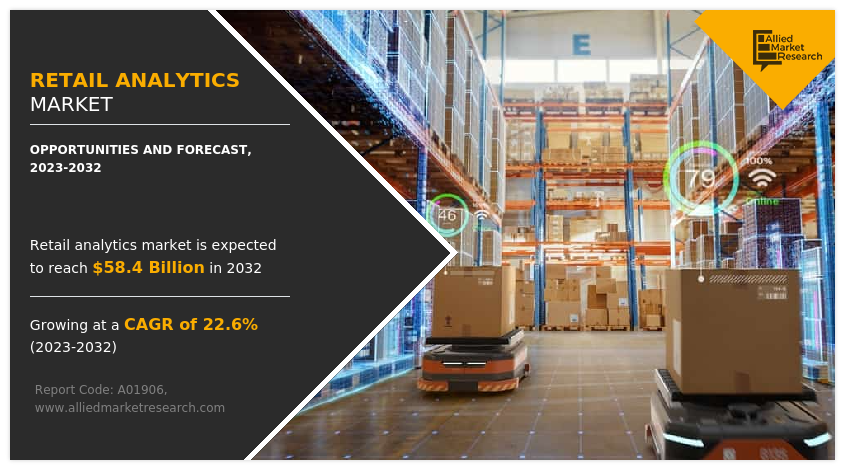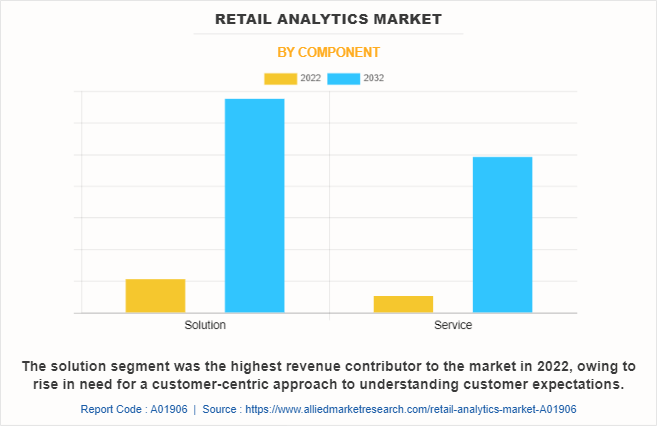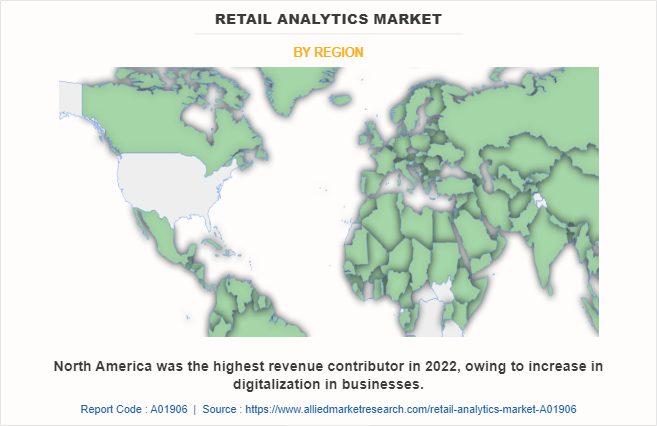Retail Analytics Market Overview
The global retail analytics market was valued at USD 7.8 billion in 2022, and is projected to reach USD 58.4 billion by 2032, growing at a CAGR of 22.6% from 2023 to 2032.
The increasing volume and variety of different data have the potential to create several benefits for retail businesses and consumers. Moreover, the surge in digital transformation and the growing trend of e-commerce platforms is likely to expand the adoption of retail analytics solutions and services among organizations. Retailers are using analytic solutions to optimize customer experiences, personalize recommendations, and increase conversion rates in the digital space. In addition, the continuous advancements in technology, such as big data analytics, cloud computing, machine learning, and artificial intelligence, have made retail analytics more accessible to users. Such enhanced factors are expected to provide lucrative opportunities for retail analytics market growth during the forecast period.

Furthermore, the rise in demand for intelligent analytical solutions is positively impacting the growth of the market. In addition, businesses can connect and analyze data from physical stores, e-commerce platforms, mobile apps, and other channels using retail analytics, to provide a consistent and tailored omnichannel experience. Furthermore, the expansion of retail analytics in several sectors including e-commerce, consumer goods, and supply chain is expected to provide lucrative growth opportunities for the market during the forecast period. Moreover, the increase in deployment of cloud computing technology to allow real-time processing of data and reduce latency to enable scalability, flexibility, and cost-effectiveness is anticipated to create lucrative opportunities for retail analytics market growth.
Moreover, the growing proliferation of smartphones and the increase in the growth of e-commerce industries in several countries positively impact the growth of the market in the future. In addition, the surge in adoption of cloud-based solutions is expected to boost market growth. However, a lack of technical expertise is expected to hamper market growth. In addition, data privacy concerns can deter the adoption of these technologies in businesses. Furthermore, the increase in integration of data analytics in the retail sector is expected to provide numerous opportunities for the growth of the global retail analytics market. Moreover, the rise in penetration of digital technologies in businesses is expected to offer remunerative opportunities for the expansion of the global market during the forecast period.
Introduction
Retail analytics refers to the use of data analysis and computational techniques to gain knowledge of various components of retail operations. It includes collecting, processing, and analyzing data from numerous sources, including sales transactions, customer interactions, inventory records, and marketing campaigns, to inform decision-making and drive business performance. In addition, it empowers retail businesses to gain a better understanding of their business operations, respond to retail analytics market dynamics, and make more informed decisions to expand growth opportunities and profitability. The retail analytics market is segmented into component, deployment mode, organization size and business function.
Segment Review
The retail analytics market is segmented into component, deployment mode, organization size, business function, and region. By component, it is bifurcated into solution and service. By deployment mode, it is divided into on-premise and cloud. By organization size, the market is classified into large enterprises and small and medium-sized enterprises. By business function, the market is segregated into customer management, in-store operation, strategy and planning, supply chain management, marketing and merchandizing, and others Region wise, it is analyzed across North America, Europe, Asia-Pacific, and LAMEA.

On the basis of component, the global retail analytics market share was dominated by the solution segment in 2022 and is expected to maintain its dominance in the upcoming years, owing to the increase in adoption of retail analytics solutions in the e-commerce and supply chain management sector. However, the services segment is expected to witness the highest growth, as the services segment in the retail analytics market provides consulting, implementation, integration, training, and support services to businesses.

By region, North America dominated the market share in 2022. North America is known for its technological advancements and innovation. The region has been at the forefront of adopting and leveraging the latest technologies, including retail analytics, which are anticipated to propel the growth of the market. However, Asia-Pacific is expected to exhibit the highest growth during the forecast period. The region has witnessed a surge in e-commerce adoption, with countries such as China, India, and Southeast Asia experiencing significant growth in online retail is expected to provide lucrative growth opportunities for the market in this region.
Key Market Players
Retail analytics key players such as SAS Institute Inc., Oracle Corporation, Microsoft Corporation, HCL Technologies Limited, Salesforce.com Inc., IBM Corporation, Amazon Web Services, Inc. , MicroStrategy Incorporated, SAP SE, Teradata Corporation.
Top Impacting Factors:
Growing Proliferation of Smartphones:
The rise in the trend of smartphone devices in several sectors and among individuals is directly influencing the growth of the global retail analytics market. In addition, customers are increasingly using their mobile phones for online shopping, with customers purchasing through mobile applications or mobile-optimized websites. These mobile transactions' generated data offer important insights into consumer behavior, preferences, and purchasing trends. Consequently, retail analytics solutions are gaining significant adoption to increase the use of IT and control systems among retail operators, particularly smartphone usage and other digital technologies.
In addition, increased use of smartphones and the internet helps consumers to easily access online shopping platforms, by simply downloading the e-commerce application on their phones. Such ease of access has contributed to increased adoption for the global market, which in turn is expected to enhance the retail analytics market trends, globally.
Furthermore, the integration of smartphones and the internet solution enables an effective user experience for retail analytics services. Retailers are increasingly presenting mobile applications to interact with consumers and offer personalized shopping experiences. Hence, these multiple benefits offered by smartphones and internet use in retail operations are projected to boost the demand for the retail analytics market. Moreover, several public and private organizations are continuously involved in promoting digitalization in analytical operations.
For instance, in January 2023, Microsoft partnered with AiFi; in this alliance Microsoft launched Smart Store Analytics, which is a part of Microsoft’s Cloud for the retail product suite. Smart Store Analytics provides retailers with shopper and operational analytics for their fleets of smart stores using AiFi’s technology, which in turn, augments the retail analytics market growth on a global scale.
Growing Adoption of Cloud-based Solutions:
The surge in the expansion of cloud-based analytics solutions in the retail industry is a key driver for the retail analytics market forecast. Cloud computing provides the underlying infrastructure and resources required to deliver analytics solutions to end users, making it an essential enabler for cloud-based retail analytics solutions. This is attributed to the rise in number of countries committing to adopt cloud-based solutions. Further, government policies are undertaking increased initiatives to embrace advanced technology, with plans for integrating a new digital solution.
For instance, in April 2023, the Japanese government raised $31.7 million (4.2 billion yen) in funding to develop shared quantum computing using a business-friendly cloud platform. The Japanese government intends to broaden quantum computing's accessibility so that businesses may take advantage of its benefits. Therefore, cloud-based retail analytics gained wider traction among end users, taking advantage of cloud computing solutions in retail industries. Moreover, cloud-based solutions leverage the economies of scale provided by cloud computing. Organizations can avoid the upfront expenses associated with purchasing and maintaining on-premises hardware infrastructure. Consequently, regional governments and private and public businesses invest in cloud computing solutions. Such advancements in cloud computing eventually contribute toward the growth of the global retail analytics industry.
Regional Insights:
North America dominates the retail analytics market due to the early adoption of advanced technologies and the presence of major retail chains like Walmart and Amazon, which heavily invest in data analytics to enhance customer engagement and streamline operations. The U.S. and Canada lead in leveraging AI, machine learning, and big data analytics to optimize inventory management, customer behavior analysis, and personalized marketing strategies. Retailers in this region are also using analytics to support omnichannel strategies, enabling seamless integration between online and offline sales.
Europe is another significant region in the retail analytics market, with countries like the UK, Germany, and France driving growth through digital transformation in the retail sector. European retailers are increasingly adopting analytics tools to enhance customer experiences, improve supply chain management, and comply with stringent regulations like the GDPR. The shift towards e-commerce, accelerated by the COVID-19 pandemic, has further fueled the demand for retail analytics in the region, particularly for customer insights and sales forecasting.
Asia-Pacific is experiencing the fastest growth in the retail analytics market, with countries like China, Japan, and India at the forefront of this expansion. The rapid growth of e-commerce, increasing mobile penetration, and the adoption of AI-driven technologies in retail are key drivers. In China, retail giants like Alibaba are heavily investing in analytics to gain real-time insights into consumer behavior, optimize marketing campaigns, and manage inventory. In India, the surge in online shopping and digital payments is driving the demand for retail analytics solutions to manage large volumes of data and enhance customer loyalty programs.
Key Industry Developments:
In June 2023, IBM partnered with leading retailers in North America to launch an AI-driven retail analytics platform aimed at improving inventory management and customer behavior insights. This development focuses on leveraging machine learning to offer real-time data analytics for better decision-making.
In August 2023, SAP introduced its Retail Insights platform in Europe, which integrates big data and AI to provide personalized recommendations for customers, optimize supply chains, and enhance store operations. This platform aims to help retailers increase their operational efficiency and improve customer satisfaction through predictive analytics.
In September 2023, Alibaba announced the expansion of its AI-powered Retail Cloud platform across Asia-Pacific. This platform leverages advanced analytics to provide real-time insights into customer preferences and shopping patterns, enabling retailers to adjust pricing, optimize marketing strategies, and improve customer engagement. The platform's success in China is now being replicated in other Asian markets, driving the adoption of retail analytics in the region.
Key Benefits for Stakeholders
The study provides an in-depth retail analytics market analysis along with the current trends and future estimations to elucidate the imminent investment pockets.
Information about key drivers, restraints, and opportunities and their impact analysis on the retail analytics market size is provided in the report.
The Porter’s five forces analysis illustrates the potency of buyers and suppliers operating in the retail analytics industry.
The quantitative analysis of the global retail analytics market for the period 2022–2032 is provided to determine the retail analytics market potential.
Retail Analytics Market Report Highlights
| Aspects | Details |
| Market Size By 2032 | USD 58.4 billion |
| Growth Rate | CAGR of 22.6% |
| Forecast period | 2022 - 2032 |
| Report Pages | 286 |
| By Component |
|
| By Deployment Mode |
|
| By Organization Size |
|
| By Business Function |
|
| By Region |
|
| Key Market Players | Teradata Corporation, Amazon Web Services, Inc. , IBM Corporation, MicroStrategy Incorporated, Microsoft Corporation, Oracle Corporation, SAS Institute Inc., HCL Technologies Limited, SAP SE, Salesforce.com Inc. |
Analyst Review
As the retail analytics industry continues to evolve, CXOs are evaluating the opportunities and challenges regarding this emerging technology. The retail analytics industry has grown rapidly in response to the massive amounts of data generated by consumers on offline stores and online shopping platforms, and the need for enhanced analytics and decision-making solutions. CXOs are considering the benefits that retail analytics can offer, such as enhanced customer experience, improved operational efficiency, and cost optimization.
In addition, retail analytics can help organizations to gain a competitive advantage essential in the retail industry. Such factors are expected to provide lucrative opportunities for market growth during the forecast period. Furthermore, by analyzing data on inventory levels, supply chain performance, and workforce management, CXOs can identify areas for improvement, streamline processes, and reduce costs. In addition, retail analytics enables businesses to optimize resource allocation, identify operational bottlenecks, and improve overall business efficiency.
However, CXOs also recognize the challenges associated with retail analytics such as data quality and integration. These primary issues ensure the quality and consistency of data, which can make it complex for organizations to integrate and cleanse the data for analysis. In addition, implementing and effectively utilizing retail analytics requires a skilled workforce with expertise in data analysis, statistical modeling, and data visualization, which can be a barrier to growth of the market. Furthermore, retail analytics frequently demands a strong technological infrastructure, to handle enormous data volumes and complete difficult analytics tasks. CXOs must integrate the solutions and services based on the advanced technological setup, including factors such as scalability, reliability, and security.
By addressing these challenges, CXOs can unlock the full potential of retail analytics to transform their retail operations, create value, and gain a competitive advantage in their industry. For instance, in March 2022, Snowflake launched a data cloud for the retail industry, the platform is further dedicated to addressing the challenges faced by the retail industry.
The new retail data cloud solves this challenge by combining together industry-specific data sets and several partner solutions on a single platform.
The global retail analytics market was valued at USD 7.8 billion in 2022, and is projected to reach USD 58.4 billion by 2032
The Retail Analytics market is projected to grow at a compound annual growth rate of 22.6% from 2023-2032.
Amazon Web Services, Inc., HCL Technologies Limited, IBM Corporation, Microsoft Corporation, MicroStrategy Incorporated, Oracle Corporation, Salesforce.com Inc., SAP SE, SAS Institute Inc., and Teradata Corporation, are some of the top companies.
The North America is the largest market for the Retail Analytics.
The increasing volume and variety of different data have the potential to create several benefits for retail businesses and consumers. Moreover, the surge in digital transformation and the growing trend of e-commerce platforms is likely to expand the adoption of retail analytics solutions and services among organizations.
Loading Table Of Content...
Loading Research Methodology...



